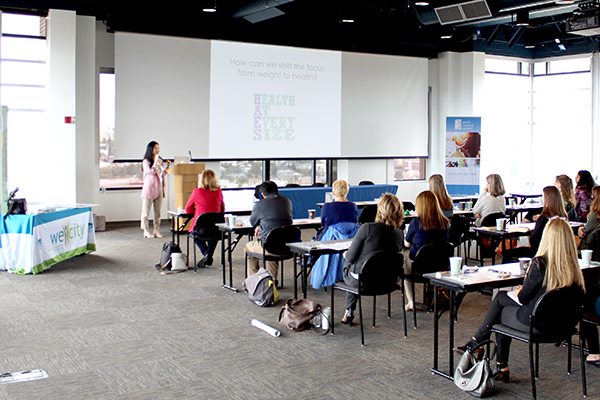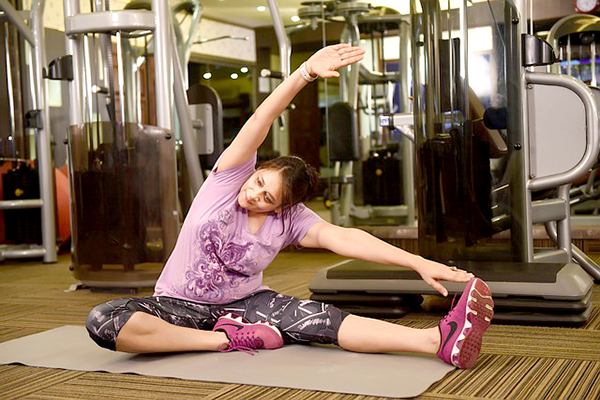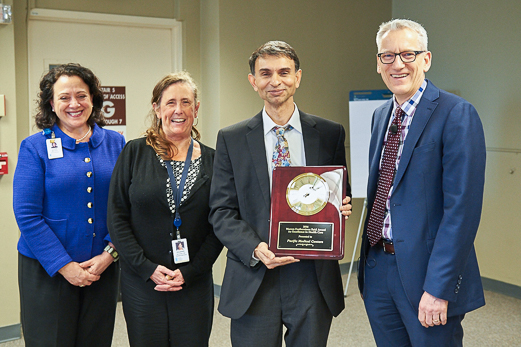Smart Nutrition Choices for Eye Health
How does diet play into vision health?
Studies have shown that some nutrients may help prevent age-related macular degeneration (AMD). AMD is a common eye condition and the leading cause of vision loss in people over 50 years old. While specific vitamins and supplements are promoted as beneficial, experts agree that the best method is simply to consume a varied diet that’s rich in antioxidants, lutein and zeaxanthin.
Recommended sources of these specific nutrients include:
- Dark green vegetables, especially kale, spinach and Swiss chard
- Most vegetables, especially corn, squash, tomatoes and sweet potatoes
- Most fruits, especially nectarines, oranges and papaya
- Egg yolks
In addition to diet, certain lifestyle factors can also affect eye health. Be sure to exercise regularly, avoid smoking and maintain normal blood pressure, blood sugar and cholesterol levels. Check in with your eye care professional on a regular basis as well to receive prompt treatment for any macular issues.
Want to learn more about nutrition? Learn more about our team of dietitians.
6 Tips to Keep You Lookin‘ Good
The signs and symptoms of many eye issues are so mild that you may not notice them. The best solution? Get routine eye exams. Plus, these six tips are good for eye health.
- Take a “20-20-20” break. Do you get eye strain from computer work or doing close work? Follow the 20-20-20 rule: Look up every 20 minutes and focus on an object 20 feet away for 20 seconds.
- Choose good sunglasses. UV-blocking sunglasses delay the development of cataracts, help prevent eye damage and help prevent wrinkles and cancer. Choose sunglasses that block 100% of UV-A and UV-B rays.
- Get to know your family tree. Know your family’s history of eye disease. You may be at increased risk for those diseases and may need close monitoring.
- Ouch! Use protective eyewear. The US has 2.5 million eye injuries each year. But many could be prevented! For home projects, choose ANSI-approved eyewear. Wear protective eyewear designed specifically for your sport.
- Stub out that cigarette. Smokers are at increased risk of developing cataracts, macular degeneration and disorders of the blood vessels of the eyes.
- Don’t abuse contact lenses. Follow the instructions about the care and use of contact lenses. Misusing them can result in serious eye conditions that can cause severe pain and vision loss.
Vitamin D.
The first step to good eye care? Make an appointment. We invite you to learn about our Optometry department.
Cataracts Prevention and Treatment
Almost everyone knows an older family member or friend who has had cataracts. But what are cataracts? Can you avoid them? How do you detect a cataract?
What is a cataract? What are the symptoms? A cataract is a clouding of the lens in the eye that impairs vision. It can occur in one eye or both. A person with a cataract may notice that their vision has become blurred or duller. They may have trouble reading or identifying colors, in particular blues and purples. Their night vision may become compromised and light-sensitive; headlights or lamps may seem too bright or to have a halo or streaks radiating from them.
What is the role of the eye’s lens? The lens in the eye is critical to seeing well. It focuses light that enters the eye onto the retina at the back of the eye, creating an image that is sent to the brain. It also focuses the eye so you can see things far away or close up. Just like a camera with a smudged lens, if the eye’s lens is cloudy, the image quality will be poor.
The lens is made of proteins and water. The proteins are precisely arranged to let light pass through. With a cataract, some of the proteins bunch together and cloud part of the lens. The cloudy area increases over time, making it more difficult to see.
Who gets cataracts? How do I reduce my risk? Although most cataracts occur in older people, others can also experience this. Some children are born with small cataracts. Cataracts also can be caused by surgery, steroid use, exposure to radiation or an eye injury. Finally, some diseases such as diabetes can contribute to your chance of cataracts developing earlier.
You may be able to reduce your risk of a cataract. Avoid UV exposure by wearing sunglasses or regular clear glasses with a UV coating. Outdoors, wear a brimmed hat. Also, get good nutrition—in particular, green, leafy vegetables, fruit and other foods with antioxidants.
It’s also very important to receive regular, preventive eye care from an optometrist or ophthalmologist. A typical eye exam is painless and measures several factors. Your eye doctor will track your vision health over time, record changes and answer your questions.
How are cataracts treated? Nonsurgical treatments aim to improve vision as much as possible. These include maximizing glasses prescription and possibly adding a tint to reduce glare; choosing reading materials with a larger font;ensuring good lighting; and wearing a hat to cut glare.
Surgery may be recommended once the symptoms have progressed to a point that it interferes with your daily activities. The cloudy lens is replaced with a clear artificial lens called an intraocular lens.
The PacMed Optometry team can assess your eye health, and our Ophthalmology department offers cataract surgery. To see which of our providers currently do cataract surgery, please visit our Cataract Surgery page.
June Wellness Symposium for HR Professionals
Attention HR employees—Save the date for our FREE wellness symposium! PacMed’s Living Well Alliance team is hosting this event to provide you with ideas on ways to enhance your company’s wellness initiatives.
Wellness Symposium
June 22, 10:00 a.m.–2:30 p.m.
PacMed Beacon Hill campus,
1200 12th Ave S
Seattle, WA 98144
This lively half-day event will include speakers and roundtable sessions on how to get your employees engaged, making your program effective while still watching your budget, helping your workforce prevent injuries and diseases and more!
Look for an official invite in May! You may also email Christy Goff, MS, RDN, CD, for more details.
The Living Well Alliance is run by Pacific Medical Centers. Call us today at 1.855.550.8799 for more information or email LivingWellAlliance@pacmed.org.
Recipe: Black-Eyed Peas and Collards
Spring is the perfect time for collards, a healthy green that’s delicious—and a classic dish—with black-eyed peas and bacon. Did you know that black-eyed peas and collard greens have a surprising amount of calcium in them? Just 1 cup of each is equivalent to 2 glasses of milk. And since May is osteoporosis prevention month, enjoy this recipe all month long! For a vegetarian dish, omit bacon and add sautéed tempeh for a crunch.
Fitness 101 for Strong Bones
Bone is living tissue, and it gets stronger when you exercise. Specifically, weight-bearing and muscle-strengthening exercise helps to increase bone density and strength; walking, climbing stairs, jogging, dancing, tennis and lifting weights all fit the bill. These forms of activity also increase coordination and balance, both helpful in preventing falls.
Another term for bone-smart exercise is “resistance training.” Resistance training is any form of exercise that forces the body to overcome an externally applied force. Lifting weights or exercising with elastic bands are good examples: your body must work against the force of the weights or the bands. Over time, resistance training increases your strength, power and bone density.
Weights are a popular form of resistance training. If you’re new to weight lifting, consider working with a trainer to learn proper technique and to slowly build your strength. A few other tips:
- Be sure to work all major muscle groups—chest, back, legs, shoulders, arms, core. Ideally, do two exercises per muscle group.
- Stay focused and use your core to stabilize your body’s alignment.
- Over time, aim for 1–3 sets of 10–15 repetitions.
- Choose a resistance that heavy enough that the last 2–3 reps are challenging.
- As you gain agility and strength, consider adding some simple devices to simultaneously improve your balance—like standing on a square of two-inch foam or an inflated rubber balance disc.
- Be sure to rest for 48 hours between workouts. A good plan is three resistance training sessions per week.
If weights aren’t your love and joy … you might try yoga, martial arts and Tai Chi. These excellent exercise forms combine strength, balance and flexibility. Pilates—whether a mat class or using Pilates equipment with a Pilates trainer—offers a good workout for your core muscles.
Before starting any new exercise activity, consult your primary care provider to make sure it is a good fit for your health situation. Looking for a primary care provider? Explore PacMed Primary Care to learn about family medicine, internal medicine and others options.
Important Nutrients for Bone Health
Three nutrients important for healthy bones are calcium, vitamin D and magnesium. Here is some useful background, plus some tips on incorporating foods that are rich in these nutrients into your daily diet.(Be sure to consult your doctor for advice regarding appropriate doses of these three nutrients.)
Besides regular weight-bearing exercise (see related article!), getting enough calcium in your diet is a key element to preventing osteoporosis. One general guideline for women who are past menopause is 1,200 mg of calcium each day.
Vitamin D and calcium go hand in hand: without vitamin D, calcium can’t be absorbed. While our bodies synthesize vitamin D through the exposure of our skin to sunlight, that can be tricky in the cloudy Northwest—and even in summer,when you block the sun’s rays with sunscreen. Vitamin D supplements are usually needed, with the recommended daily amount being 600–800 international units.
Magnesium is a mineral, and it plays a critical role in your body, including maintaining healthy bones and a healthy heart. Magnesium exists in your body in significant amounts, with the major portion contained in the skeleton. Deficiencies of this mineral can lead to your bones becoming brittle, which in time increases the risk of fractures. Most people on average need to consume 300–400 milligrams of magnesium a day.
Boosting Your Diet for Good Bone Health
Increasing your intake of dietary sources that are rich in calcium, vitamin D and magnesium can support a personal health goal to maintain strong, resilient bones. As always, work closely with your medical provider to create a care plan that’s right for you.
Calcium. Calcium is found in dairy products (for example, milk, yogurts and cheese), fortified juices, canned salmon and some plant sources such as tofu. Try making “tuna melts” with salmon instead of tuna, or enjoy plain, low-fat yogurt with fresh fruit for a mid-morning snack.
Vitamin D. Vitamin D is in milk and some yogurt and can also be found in eggs, mushrooms and some fortified foods. Starting your day with a hardboiled egg or having a glass of milk instead of your midday soda can help.
Magnesium. Foods rich in magnesium include green leafy vegetables, whole grains, beans and nuts. Fresh fruits and vegetables also provide a modest amount of magnesium.
For more information about PacMed and our dietitian services, please visit www.PacMed.org. To make an appointment, use our appointment tool or call 206.505.1300.
Bone Up on Osteoporosis
Understand your risk factors, when to get screened and ways to protect your bone health.
Osteoporosis, which means “porous bone,” is a silent disease that can have devastating effects. With this disease, bone tissue and mass deteriorate, which leads to frail bones and a higher risk for serious fractures.
“The kicker,” says Dr. Mary Wemple, a rheumatologist at PacMed, “is that this bone-loss condition occurs without symptoms. That’s why screening is so critical.” Because bones weaken gradually over time, people may not know that they have osteoporosis until a sudden strain, bump, or fall causes a fracture.
In the U.S. today, 10 million people already have osteoporosis. Although osteoporosis cannot be cured, it can be effectively treated. Most important, it can be prevented.
Who Is at Risk?
Older women are particularly susceptible. Risk factors for osteoporosis include:
- Being female
- Going through menopause
- Male or female—being slim and less than 130 pounds
- Smoking cigarettes
- Drinking excess alcohol (more than three glasses daily)
- Having a first-degree relative with osteoporosis
- Age—the older you are, the greater your risk
Certain health conditions, medications and ethnicities can also play a factor.
Who Should Get Screened?
Screening for osteoporosis involves a bone density scan. This scan is a quick, painless procedure that uses an enhanced, low-radiation form of X-ray technology called DXA (pronounced “dexa”).
- Women: If you are over age 65, screening is highly recommended. If you are younger than 65 but have risk factors, you may benefit from screening.
- Men: If you are over age 70, you should discuss bone density screening with your primary care doctor. If you are younger than 70 but have risk factors, you may benefit from screening.
What Preventive Steps Can I Take?
Two of the most important steps are to get the daily recommended amounts of calcium and vitamin D, and to regularly engage in weight-bearing, muscle-strengthening exercise. Talk with your primary care doctor for guidance, and read the related articles in this month’s Healthy Tips on nutrition and exercise suggestions for good bone health.
The message Dr. Shailaja Reddy drives home with her patients is one of awareness and prevention. “Get your calcium and exercise, even if you’re in your forties,” she recommends. “If you do this consistently from a younger age it will help you down the road.” Dr. Reddy practices internal medicine at PacMed.
Already diagnosed with osteoporosis? Learn more about the Rheumatology team at PacMed.
PacMed Wins Warren Featherstone Reid Award for Excellence in Healthcare
Pacific Medical Centers is proud to announce that it has been given the 2016 Warren Featherstone Reid Award for Excellence in Healthcare. This distinguished award recognizes and honors healthcare providers in Washington who go above and beyond in providing the highest-quality care for its patients. This honor exemplifies the commitment Pacific Medical Centers makes to its community in providing expansive healthcare access, quality clinic care and innovative, creative health services.
The Warren Featherstone Reid Award recognizes Pacific Medical Centers’ efforts to champion change in removing hurdles for underinsured patients. Pacific Medical Centers was a founding member of Project Access Northwest, which established core programs specifically committed to helping patients navigate their diverse healthcare needs ranging from medical to dental, regardless of coverage status.
This esteemed award recognizes the high-quality care benchmarks that Pacific Medical Centers sets for the community. For instance, Pacific Medical Centers was rated by the National Committee for Quality Assurance in the 90th percentile for six diabetic measures, and above the 75th percentile for preventative cancer screening measures. Additionally, Pacific Medical Centers has provided nearly 24,000 medical referrals over the past ten years, and has changed hospital policies to expand care to a greater number of Charity Care-eligible patients.
Pacific Medical Centers is dedicated to expanding access to patient-centric, quality and affordable medical care to ensure everyone has a chance to lead a healthier life. Please join us in congratulating our dedicated teams across 11 clinics and our inspirational leader, CEO Linda Marzano, on receiving the Warren Featherstone Reid Award for Excellence in Healthcare. Our team’s tireless efforts will continue to bring impactful change to Puget Sound healthcare access and quality of care.
New Spring Classes from the Living Well Alliance
Classes from the Living Well Alliance help local organizations provide wellness programming to their employees. Their 45- to 60-minute classes are interactive, fun, current—an easy fit for your worksite.
This spring, we are rolling out a two new Take a Break to Educate classes:
- Participants in our new Quick, Healthy Meals class will gain skills to help them pull together nutritious meals when there is no time to spare. Together, we will discuss how to plan a meal, be efficient in the grocery store and cut corners in the kitchen to save time, dirty dishes and sanity.
- In Brain Boost, participants will learn ways to help protect their brain against memory decline as they age. The class will touch on various nutrition and lifestyle factors.
Our up-to-date, research-based topics can help you promote health and disease prevention among your employees. All classes are taught by qualified health professionals.
Learn more at the Living Well Alliance website. For the latest class information, click the Take a Break to Educate button for class descriptions and the Program and Services button for pricing.
The Living Well Alliance is run by Pacific Medical Centers. Call us today at 1.855.550.8799 for more information or send us an email.












